Western Digital Expands HGST Helium Drive Lineup with 10TB Ultrastar He10
by Ganesh T S on December 2, 2015 3:01 AM EST- Posted in
- Enterprise
- Storage
- HDDs
- Western Digital
- HGST
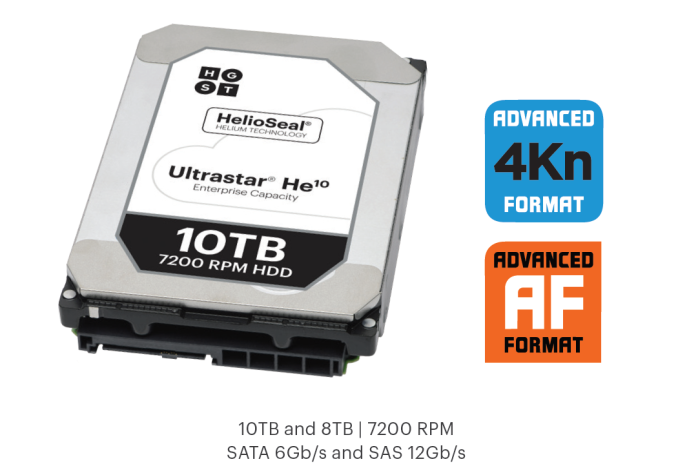
HGST, a Western Digital subsidiary, has been shipping hard drives sealed with helium for a couple of years now. Their helium drives have so far come in two flavors - the Ultrastar He drives using platters with traditional perpendicular magnetic recording (PMR) technology and the Ultrastar Archive Ha drives using platters with shingled magnetic recording (SMR). There are two main patented innovations behind the helium drives, HelioSeal and 7Stac. The former refers to placement of the platters in a hermetically sealed enclosure filled with helium instead of air. The latter refers to packaging of seven platters in the same 1" high form factor of traditional 3.5" drives.
The Ultrastar He6 6TB drive was introduced in November 2013, and this was followed by the He8 8TB drive late last year. In June 2015, the Ultrastar Ha10 SMR drive with HelioSeal technology was introduced. Around the same time, HGST also made it known that more than 1M HelioSeal units had been deployed. 1.33 TB platters have become available in air drives now, and HGST is taking advantage of that in the 10TB Ultrastar He10. The launch of the Ultrastar He10 PMR drive today also brings the news that more than 4M HelioSeal units have been deployed in various datacenters - pointing to the rapid rise in adoption rate of this technology.
We have already seen in our reviews that the helium drives offer the best performance to power ratio and watts per TB metric amongst all the drives in their capacity class. HGST also claim a 2.5M hour MTBF - much higher than traditional enterprise PMR drives. The initial cost of the helium drives have been substantially higher compared to the standard drives of the same capacity, but the TCO (total cost of ownership) metric is highly in favor of these drives - particularly for datacenter customers who need the drives to be active 24x7. HGST's press briefing included a slide that presented the potential TCO benefits that come about due to the increased capacity per rack, lower consumption per rack and lower power consumption per TB of the new He10 drives.
HGST indicated that the ramp in volume should help the initial cost to approach that of the air drives in the near future. For datacenter customers, that would mean an acceleration in obtaining the TCO benefits.
Coming to the core specifications, the Ultrastar He10 will come in both SATA 6Gbps and SAS 12Gbps varieties. The drives have 4KB sectors, though SKUs with 512-byte emulation are also available. Various data security options such as instant secure erase, self-encryption, secure erase and TCG encryption with FIPS are available.
The standard Ultrastar He drive features such as rotational vibration safeguard (for better RV tolerance in multi-drive servers) and the rebuild assist mode (for faster RAID rebuild) are retained. The drives come with a 256MB DRAM buffer.
Hard drives are struggling to reach the 10TB capacity point with traditional PMR technology. While Seagate did announce a few 8TB PMR drives earlier this quarter, it really looks like vendors need to move to some other technology (shingled magnetic recording or heat-assisted magnetic recording (HAMR)) in order to keep the $/TB metric competitive against the upcoming high-capacity SSDs. As of now, helium seems to be the only proven solution causing minimal performance impact and HGST appears to have a strong hold in this particular market segment.



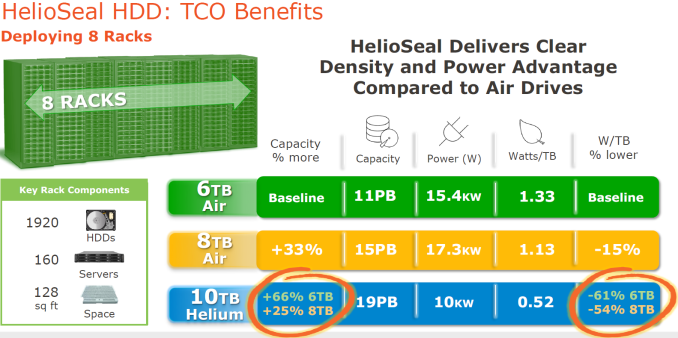
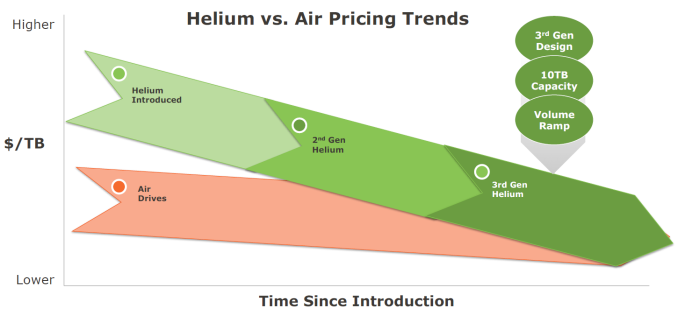
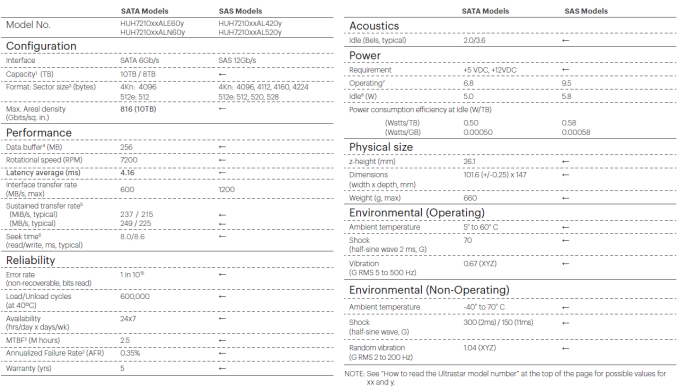
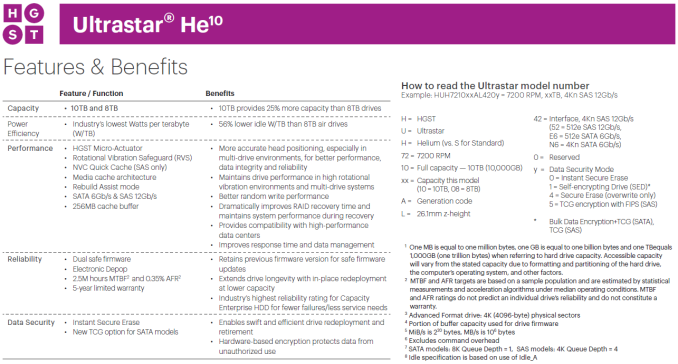








113 Comments
View All Comments
ddriver - Wednesday, December 2, 2015 - link
What I want to see is 5.25 inch form factor HDDs. It will be a tremendously boost not only to capacity, but also to sequential performance as well. Larger head count, independently operating heads, increased cache size - 512 mb at least with in memory defragmentation for small random writes, and integrated nano UPS, capable of supporting the drive until all cache is hard stored in case of a power failure.This will make possible 30-50TB HDDs, capable of sustaining 1+ GB/sec transfers on workloads which are well distributed over the platters.
shodanshok - Wednesday, December 2, 2015 - link
While 5.25" platters seem a good idea, this is probably not true.5.25" platter would be much vibration-prone, with resulting lower RPM (< 4000, probably).
Moreover, a bigger platter size implied bigger/heavier actuator and heads, with lower precision and consequently lower platter density.
Platters with multiple, concurrent heads were tried in the past, but with current high platter density they are probably not feasible.
On the other hand, I +1 the idea of power-protected write caches (which _are_ already available on selected enterprise-class disk).
ddriver - Wednesday, December 2, 2015 - link
Lots of speculation, no facts, just a load of "probably" without argumentation. The difference in radius is ~35%, the difference in surface area is over 100%. Independently operating heads and actuators, even if 35% larger, will actually be lighter than current approach where they are stuck together. Tried in the past - technology has improved a lot since then, you can have 2 to 6 independent heads per platter face without going in each other's way. This means tremendously lower latencies, as there are multiple heads available at each 1/head count platter revolutions.Larger platters means higher sequential speed, and a larger percent of the capacity would be in the fast area. Larger form factor means more room for platters - 10 are feasible. Which means at the same storage density of those 10TB HE drives, you can have a 40 TB drive that can easily push 5-6 GB per second transfers at lower PRM. Naturally such a drive would require multi-lane PCI-E and a good 4-8 GB cache/ram. With good caching policies this will annihilate SSD in pretty much every area at a better price safe for applications for vibration heavy environments.
It is entirely doable, but not done for a number of reasons, and no, complexity is not one of them.
ddriver - Wednesday, December 2, 2015 - link
Also, independent heads offer a boost in redundancy - such a drive can lose components, which are vital to current HDD implementations, while still retaining some or even full operation, albeit at reduced throughput. Head and/or platter parallelism and other advantages on top of that.close - Thursday, December 3, 2015 - link
So you suggest a 10 platter design with independent heads. So basically 20 actuators. And the "brain power" to control all of them. So you have 20 actuators, a much bigger motor, higher inertia and stresses (due to increased weight - an increase in surface usually brings an exponential increase in volume and weight). That's an increase in power consumption, BoM, noise and research needed to put it all together in a world where SSDs are already getting close to the price per GB of spinning disks. Any reason I'd choose a slow and sensitive "spinner" and not the much faster and more resilient SSD at the same price?Also, remember Samsung already has 16TB 2.5" SSDs. Absolutely 0 reason to go for a clunky, mechanically complex 5.25" device that's extremely susceptible to any mechanical shock and that doesn't fit most devices out there (moving to 2.5" can't be done fast enough).
So I will urge you to quote a paper that actually researched this implementation with concrete details and not just submit lots of speculation, no facts, just a load of "probably" without argumentation because you seem to like the idea.
I suggest an arrangement with 4 stacks of platters (square formation) and the heads positioned in the center of the stack. Then the heads could quickly spin from one stack to another to access the data there. With a bit of software optimization you wouldn't even tell the difference. Much better for archiving than SMR. Also you can use just one bigger motor that can decouple from any stack independently to reduce load instead of 4 smaller ones. Also the design is scalable: in a box the size of a standard NAS you can fit 10-20 times the data,
It is entirely doable, but not done for a number of reasons, and no, complexity is not one of them. It actually reduces complexity by reducing the number of parts, especially moving ones.
And since I just explained you in a few words how it would work this is clearly not speculation, assumption, etc. It's fact.
I also have some "spinning sphere" research.
ddriver - Thursday, December 3, 2015 - link
"So you suggest a 10 platter design with independent heads. So basically 20 actuators. And the "brain power" to control all of them."10 platters - 20 faces, optimal config of 4 heads per face - that's actually 80 actuators. 2 heads per face makes for 40. Each of those heads can access different areas of the platter individually, capable of 70-150 MB/sec transfers. The brainpower will not be as much, neither in terms of silicon area nor power consumption.
"That's an increase in power consumption, BoM, noise and research needed to put it all together"
It will still be more efficient, cheaper and substantially faster than the n number of regular HDDs needed to match its capacity. The concept is basically numerous worker heads sharing the same hardware. You sill will only have one motor, one case, one power sully, one "brain", one cache buffer.
"Also, remember Samsung already has 16TB 2.5" SSDs."
And it costs a set of good kidneys, and is still flash memory with a finite PE cycle count. Nor is it capable of the kind of concurrent throughput I am talking about.
35% larger platters, motor and case, more platters, let's be generous and say that alone will cost 50% more than a regular size HDD. The actuators - when mass produced will be pretty cheap, there is not much to them, it is basically some steel profiles, some copper wire and a magnet. Add in the 4-8 GB of ram and the 50$ of components needed to drive the whole thing and transfer data back and forth the PCI-E buss - the BOM will roughly come at twice that of a regular HDD, at 4 times the capacity, at least 30 times the throughput and tangibly lower latency. All in all, due to the sharing of the mechanics, it will use less power, generate less heat and noise and cost less than the number of HDDs needed to match the capacity alone. And hey, fast large SSDs are not exactly known for their stellar power consumption either.
close - Thursday, December 3, 2015 - link
Maybe but do you have any concrete research or only speculations and assumptions?Also you make several glaring mistakes:
"It will still be more efficient, cheaper and substantially faster than the n number of regular HDDs needed to match its capacity."
How exactly is a drive that needs countless months of research and testing less complex than a few of the "good ol' drives" of today? How exactly is 80 independent actuators less complex than the tech found in any run of the mill $50 drive of today?
"The actuators - when mass produced will be pretty cheap, there is not much to them, it is basically some steel profiles, some copper wire and a magnet."
I don't think you know what the actuator is. You are describing the *actuator arm*. That arm doesn't just do stuff, it needs the actuator. That's a motor to actuate the arm. That's 80 little motors that should move 80 little arms all over the platters at great speed and precision.
"and is still flash memory with a finite PE cycle count"
You are forgetting that hard drives suffer from more mechanical failures than SSD suffer from PE cycles limitation. You will now have 80 little motors and one big motor (and I mean BIG, it has to spin 20 heavy platters) that will suffer wear and tear.
I think it's a lot simpler to create chips with 3D stacking. 512 or 1024 dies stacked together shouldn't cost that much. Also you can achieve low power consumption by using new fabrication techniques and materials. I would say at least 60-80% lower power usage. This way in 2 years we could have a 32-64TB SSD that consumes less power than the 5.25" hard drive motor alone.
close - Thursday, December 3, 2015 - link
Really missing an edit button here. 80 actuators that work independently also eat up a lot of energy, along with that big spindle in the middle. One that takes ages to exit standby because of inertia alone. So having 10 10TB drives means that you can have 9 in standby and still access your data. One 10TB drive is "always on".And in the end you still end un with niche technology that could either work only in enterprise (no problems there since you can use unusual form factors even now - thick 2,5" or 3.5" drives, different connectors, etc.) or in full size desktops. Which, as you may have noticed, are fading away. Because most people would rather have reasonable capacities in a really small package than have enormous capacities in a big package.
And those actuators need to be positioned all around the platters in order to ensure the arms don't intersect. This means a 5.25" platter will need an enclosure that's wider than a standard optical unit. Look at an open HDD (random pic http://www.hardwaresecrets.com/wp-content/uploads/... and you'll see that there's no way to put 4 arms without increasing the size on all sides. Making a drive that doesn't fit in any computer case. Or you drop the size of the platter and you have to adjust the speculated numbers.
And a hard drive, no matter how many actuators you cram inside cannot keep up with solid state memory speed wise.
If the spinning disk industry had a trump card like this they would have used it. But most likely it's not feasible. I agree with you that profit is the end game but they see their market share shrinking and still don't come up with this.
ddriver - Thursday, December 3, 2015 - link
A 10 platter drive with 4 actuators/heads per platter face is doable in the form factor of those older CD/CDRW/DVD/DVDRW drives - the longer ones.The actuators snugly fit in the four corners, and although numerous, they are individually much lighter than the actuator of a regular HDD, therefore they need much smaller coils. They will only use power when the workloads demands it, otherwise they are parked and use no power whatsoever. The extra power they'd use while in operation offers a very good return in performance, since you have numerous heads working but spinning only one set of platters.
And no, contrary to your "expert" opinion, there are no "motors" in HDD actuators, you demonstrate profound cluelessness in the subject.
NVMe SSDs already exceed the power consumption of mechanical HDDs, I seriously doubt power consumption will go down as you add more DIEs. Semiconductor production will never become cheaper than platter production, as it is an immensely more complex, time consuming and environment unfriendly process, and is soon bound to run into a brick wall, which will prohibit any further scaling down of process node size.
The industry is not in the habit of aiming to provide the consumer with the best value for his money. An example - intel keeps cramming iGPUs into 400+ $ processors, even though hardly anyone, willing to pay that much for a CPU, would be willing to settle with their mediocre performance, and all that DIE area would be much better invested in twice the CPU cores. But such a product would offer too good valie, more than intel is willing to provide to consumers at this point, so it will keep wasting DIE area on lousy iGPUs, and the chips which are spared that utter waste will come at a significantly higher price.
Similar examples can be seen anywhere you look, provided that besides the ability to look you also have the ability to see ;) The product I speak of doesn't exist for the sole reason it is far better value than what the industry would like to offer. And no, it is not as easy as "kickstarting" your own foundry to make what the industry refuses to, even if you could gather the billions this will cost, you will run into patent trolling, because none of the big players who "own" the tech would be willing to allow you to humiliate them in such a manner, nor to extort and force them into providing better value than they are willing to.
Capisce?
close - Friday, December 4, 2015 - link
So you don't know that a voice coil actuator *IS* a motor and that while the "copper wire" might be enough to make some shiny loops for you to chew on it's not enough to actually "actuate" but you claim to be a star hard disk designer...I even gave you a damn picture http://www.hardwaresecrets.com/wp-content/uploads/... so you can understand the proportions involved because the actuator doesn't stay magically the same while still covering a 5" disk.
Somehow you find a way do dig yourself into a hole every time you comment on most articles. You just plaster suppositions, assumptions, maybes but show zero understanding of any of the things you talk about. The only thing that fits in a corner is you :).
I'm waiting for the next iteration: the truck tire sized hard disk.